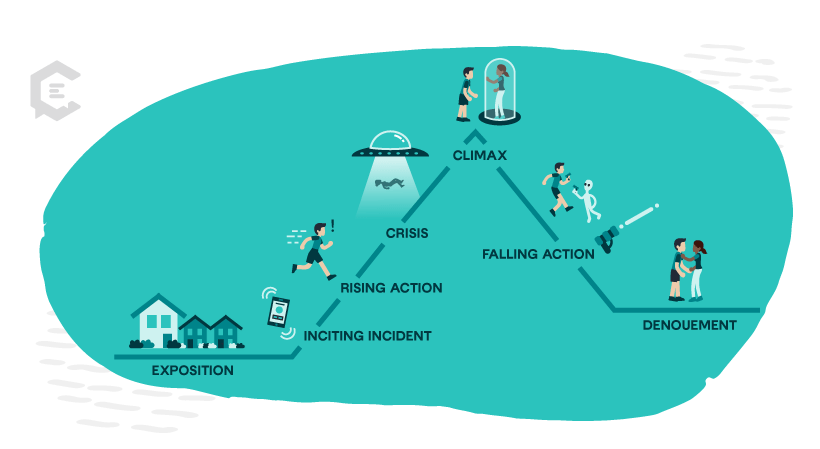Freytag’s Pyramid, a storytelling framework favored by screenplay writers, playwrights, and dramatists, is often overlooked in marketing training. But this seven-step structure is highly versatile and can enhance everything from charitable work to policy campaigns, marketing, and branding.
At its core, Freytag’s Pyramid (or Freytag’s Triangle) crafts a narrative arc that fosters sympathy for a character. It asks the audience to live in the character’s story world and feel the complexity of their problems. For marketing, its power lies in its ability to persuade audiences to believe in an idea and influence them to buy a product or service, while also feeling that they’re contributing to something larger.
In this article, we’ll explore the concept of Freytag’s Pyramid in-depth and demonstrate how you can adapt and apply it to your modern marketing efforts.
What is Freytag’s Pyramid
Human beings inherently love stories. It’s part of our DNA. That’s why using storytelling and emotions in your content can be so effective.
When we listen to a story, we instinctively look for a sequence of events that unfolds in a meaningful, chronological order.
Gustav Freytag, the 19th-century German playwright and novelist, encapsulated this desire by drawing a simple triangle to represent dramatic structure. Then, he highlighted seven elements he considered necessary to storytelling:
7 elements of dramatic structure in Freytag’s Pyramid:
- Exposition: The storyteller sets the scene and the character’s background.
- Inciting Incident: The character reacts to something that has happened, and it starts a chain reaction of events.
- Rising Action: The story builds. There is often a complication, which means the problem the character tries to solve gets more complex.
- Climax: The story reaches the point of greatest tension between the protagonist and antagonist (or if there is only one main character, the darkness or lightness of that character appears to take control).
- Falling Action: The story shifts to action that happens as a result of the climax, which can also contain a reversal (when the character shows how they are changed by the events of the climax).
- Resolution: The character solves the problem or conflict.
- Denouement: French for “the ending,” the denouement is often happy if it’s a comedy, and dark and sad if it’s a tragedy.
5 Cool Examples of How to Use Freytag’s Pyramid in Modern Marketing
Let’s break down some of the best examples we’ve seen of using Freytag’s Pyramid in modern marketing:
1. Condensing your brand’s story into a few minutes
Not all marketing campaigns or product commercials have the luxury to include all parts of Freytag’s dramatic structure in a 2-minute ad. Yet those who strive to use the paradigm when creating their content for marketing can see how it pays off.
Here’s how the nonprofit Charity: Water used Freytag’s Pyramid to tell its brand’s story and launch its monthly giving campaign, “The Spring – The charity: water story.” Take a few minutes to watch this video before continuing to read on.
The use of Fretag’s Pyramid
Here’s how Freytag labeled the steps in his pyramid and how Charity: Water founder Scott Harrison stuck to the formula to a T:
- In the beginning Exposition, Scott’s voiceover opens with the universal nature of water, how it’s essential and touches everyone’s lives. He’s creating the setting, the beginning of a story that will draw you in and let you know his backstory.
- For step 2 of Freytag’s Pyramid, the Inciting Incident, Scott brings to the forefront his mother’s illness.
- With this Rising Action (step 3), as he reveals the unraveling of his childhood and the burden of caring for a sick parent, Scott is building meaning and connection toward the main point of interest.
- Then Scott’s story reaches the Climax (step 4) when a good-Christian-boy-turns-into-New-York-City-nightclub-promoter surrounded by drugs and alcohol. Yes, “Houston: We have a problem”; and Freytag called that the complication. It’s the zenith of the story where the hero falls into darkness and has to decide to change his fate.
- In the Falling Action (step 5), Harrison leaves the nightlife and ends up on a Mercy Corp ship traveling the globe as a volunteer photographer, documenting how facial deformities cause stigma and how a band of doctors helps patients look normal again. A clear reversal. The protagonist in Scott has beaten out the antagonist in Scott.
- And his Resolution (step 6)? After seeing how dirty water causes poor people to get sick, he wants to change the world by bringing clean water to communities that don’t have access. A redeemed Scott uses his New York nightclub promoting skills to raise money to help communities get clean water.
- Denouement: He’s heading a movement to end the water crisis and wants you to join.
Key takeaways
We know, we know. We omitted that the “The Spring – The charity: water story” video lasted 22 minutes. But did you stop watching? Alas, the power of telling your story using dramatic structure.
There’s something to be said, in praise of a YouTube video about a nonprofit that can hold your attention for that long and not lose you.
The video, no doubt, is aimed at donors who have already given to Charity: Water and marks the organization’s 10th anniversary. The longer form 22-minute video might have served as a centerpiece at a fundraising gala and was re-purposed for wider audiences online.
2. Brand stories as extensions of marketing
Scott Harrison’s approach shows how your brand story is an extension of your marketing strategy.
Similarly, Blake Mycoskie, TOMS Founder and Chief Shoe Giver, recounts his trip to Argentina where he met children faced with hardship growing up without shoes. From that came his idea: One for One, where a purchase of a pair of TOMS shoes results in a gift of a pair to a child in need.
The story arc within Mycoskie’s brand follows a similar pattern to Freytag’s Pyramid, but on top of the One for One idea, the company has spread portions of profits into other areas, such as correcting vision, providing safe water and birth; and social enterprise.
Each of these areas of social work can be linked to a product that TOMS sells:
- Eyewear sold helps with sight-saving surgery or prescription glasses.
- Places where TOMS coffee beans are sourced, water access is increased.
- Handbags purchased provide new moms with safe births.
- Backpack sales go to prevent bullying in schools.
Key takeaways
In many ways, TOMS marketing blurs the lines between its for-profit business and nonprofit support so seamlessly that shoppers cannot help but buy their products just for how good it feels to wear and own something that helps others in profound ways.
The Freytag-style storytelling extends to the people TOMS serves. Stories about local leaders and community members are shared with customers to broaden the connection between buyer-donor and receiver-person-changing-their-community.
What’s notable about TOMS’ marketing approach is the sensitivity in their use of language and the imagery used in their promotional materials. When you go to their Improving Lives site, pay attention to the words, images, and graphics of the world map.
Beneficiaries are never characterized as desperate, poor, or unskilled, and the images of buyers-donors are diverse — as diverse as the beneficiaries themselves. There is an intentional strategy to make sure that the buyer-retailer-beneficiaries relationship appears as a mutually beneficial one, built on respect and team effort to make the world better.
3. Articulate your ideas creatively
Oftentimes, times marketing and branding try to be linear with ideas: This product is well-made; buying it makes life easier; buy it! Yet in a marketplace with thousands of similar products, all claiming to save you time and energy, one that ties itself to a story that has intrigue and suspense, percolates to the top of our attention.
Who could forget the 2016 Kevin Hart Superbowl Hyundai Genesis Ad?
In the ad, Freytag’s Pyramid is front and center:
- Exposition: A father (played by comedian Kevin Hart) greets an unsuspecting boy who is taking his daughter on their first date. To show he’s a nice guy, Dad lends the boy his new Hyundai Genesis.
- Rising Action: As the boy tries to bust moves on the daughter, lurking behind them is Kevin Hart.
- Inciting Incident: When the boy reaches to put his arms around the daughter while watching a movie, he turns around to see Kevin Hart slurping a drink and hiding behind a bag of popcorn. Instantly, the boy is frightened; and caught between playing the cool guy to his girl and the good boy to her dad.
- Climax: At a make-out spot overlooking Hollywood, Kevin Hart dangles from a rope off of a shark-shaped helicopter, shouting: “You’re messing with the wrong daddy!”
- Falling Action: The boy starts the car and decides to take the daughter home immediately. Reversal: Boy knows he’s messing with a crazy daddy.
- Resolution: Dad wins when his daughter gets dropped off at home early, thanks to the Hyundai Genesis Carfinder, a new feature that tracks the car wherever it goes.
Key takeaways
The Hyundai Genesis Ad helps us see how much an audience will give companies dramatic license.
Another company, which sells customer service software, makes a courageous creative leap to sell itself by telling the story of a struggling garage band that shares the same name as the software company, Zendesk.
The parody of an alternative garage band creating a concept album about customer service software comes off as rather “plausible,” and you find yourself absorbed by the story enough to sit through not-so-subtle Zendesk logo placements in almost every frame.
Within three minutes, Zendesk’s use of Freytag’s Pyramid gives a seemingly boring product (customer service software) a shiny comedic sheen that makes it memorable and kinda hip (in that parody-of-a-90’s-Seattle-grunge-band way.)
By putting together this kind of lighthearted skit, it shows the guys who run this company can make fun of themselves and will likely listen to what you need and make it happen. We’d say that’s about all one can really ask of customer service software.
4. Use subtext to entertain and educate
In a short film called ‘Burt’s Bees: Burt Talks to the Bees: Worker Bees‘, the cosmetic company which touts that all its products use 98 percent natural ingredients, delves into life in the beehive.
There is not a single mention of a Burt’s Bees face cream, lotion, or shampoo. Instead, through Burt’s questions to the worker bees and their responses, he comes to his own realization – that buying local, organic honey supports bees and their security.
The dramatic structure of how the female worker bees tell Burt how they keep hives healthy educates buyers about environmental threats bees face, such as Colony Collapse Disorder. Rendered through beautiful paper-cutting art and a cameo by famed actress and film creator Isabella Rossellini, the film enchants while it educates.
There is no plug for Burt’s Bees explicitly, but at the end of the film its subtext convinces you that Burt and his company care about the environment, the sustainability of bees, and how that carries over into his products.
An inherent part of why branding using Freytag’s method works is that it allows for subtext or undertone within its creative approach. The sales pitch is not explicitly announced by characters, but rather becomes something that is understood by the observer of the marketing as the story unfolds. This engagement of the consumers’ mind is not subliminal, but active. It stimulates them to think of the implications, benefits, and the greater good in buying the product.
5. Counter implicit bias to heighten your storytelling
Hands down, our favorite campaign, where subtext and story sync so profoundly, is “Love Has No Labels.” It counters implicit bias to heighten its storytelling by causing people to challenge the presumed narrative they already have in their heads.
We came across a video on our Facebook feed called Fans of Love, where a kiss-cam circles the crowds of an NFL Pro Bowl stadium looking for couples to zoom in on.
As the camera draws closer to couples, it hovers over a man and a woman, only to redirect its lens when the man reaches to kiss his male partner, and the crowds cheer them on. It’s emotional because it challenges implicit biases and asks you to rethink your own state of mind.
The camera continues to glide over the crowds and stops at other couples: a woman in a wheelchair with her white male partner, a Muslim woman with her African-American friend, and a lesbian couple that’s both African-American and Latina.
Each time the subtext is there: We have set ways that we define relationships, friendships, and love, but Love Has No Labels.
Key takeaways
In the Love Has No Labels campaign, changing behaviors and mindsets is the “product” they are selling, exposing how implicit biases creep into our assumptions, stereotypes, and unintentional reactions we have towards people we label as different based on race, religion, age, gender, sexual orientation, and ability. These are accumulated biases from family, media, pop culture, and often found in the subconscious, the storehouse where subtext swirls.
The amazing work of this campaign lives by the rule of telling individual stories as a form of inclusion while also hitting the point of how universally we share common dreams and goals. It works at the storytelling with subtext level so that the observer has a chance to reflect on their own reactions and take opportunities to “begin the real work of seeing and affirming who we are and who we can be.”
Skyrocket Your Storytelling
In marketing, building an emotional connection with your audience is directly related to your abilities as a storyteller. Audiences want to buy from brands whose stories resonate with their own. And when you’re trying to scale your content production and maintain a consistent message, sometimes it’s best to team up with a proven partner.
At ClearVoice, we have over a decade of experience helping companies create content that emotionally hooks an audience and drives results. Talk to a specialist today to start crafting meaningful narratives that grab your audience’s attention.







